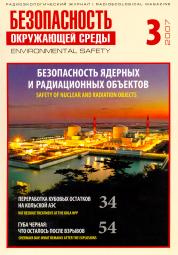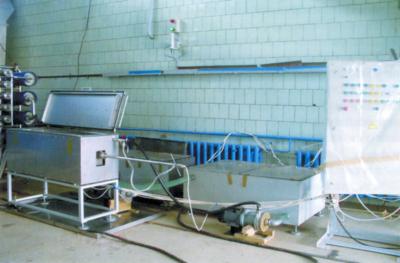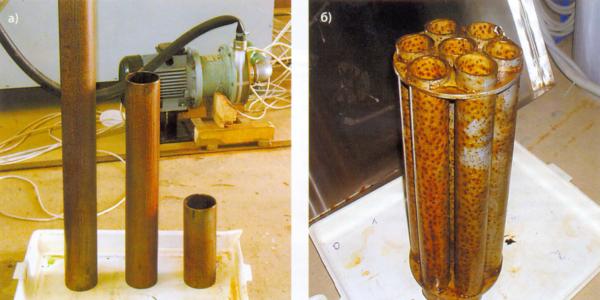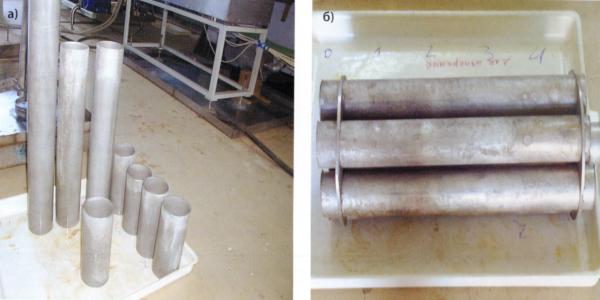Testing of Ultrasonic Decontamination Unit for Metallic Radwaste
Decontamination of metallic radioactive waste is most frequently performed using liquid methods, which are based on treatment of metallic parts with various liquid decontamination solutions, sometimes combined with other methods of treatment to intensify the decontamination process. One of such other methods is treatment by ultrasound.
Metallic Radwaste Treatment Issue
During decommissioning of nuclear power plants, military nuclear power installations, research facilities and other objects, metallic radioactive waste is generated which is represented by installations, products of various types and individual parts contaminated with radioactive matters. The volumes of such radwaste are quite significant. According to expert evaluations, there are, 12.4 million tonnes of metallic radwaste in the world now, about 2 million tonnes of which is located in Russia. Today, dozens of ship-borne nuclear power installations, which require dismantling and disposal of as part of decommissioning, represent a serious concern.
The problem is that in Russia, apart from Ecomet-S, there are no organisations specialising in processing of metallic radioactive waste. In addition, many installations that generate metallic radwaste lack facilities to decontaminate and condition such radwaste, including secondary radwaste. Often, the locations of metallic radwaste lack the necessary infrastructure for decontamination.
One of the pressing tasks of radiation safety assurance is to develop a method for metallic radwaste decontamination that could be used at sites that hold considerable amounts of such radwaste but lack the necessary means to treat it.
Decontamination of radioactively contaminated metallic surfaces is normally performed on technological process equipment with the objective of reducing the dose rate from the equipment and ensuring safety of operations staff. This decontamination is performed on regular process equipment, using special decontamination media. For metallic surfaces, liquid decontamination is normally applied.
For instance, the temporary radwaste storage location in the Andreyev Bay currently contains significant quantities of solid radioactive waste that has originated from the naval operations. It includes scrap metal of various origins and sizes, including large-dimension thick-walled items, containers for spent fuel assemblies (SFA), handling chains and other types of waste that is held both in open-air grounds and sub-surface storage locations.
On-site decontamination of such radwaste would enable removal of cleaned metal parts, including those made of stainless steel, to specialised remelting plants, thus reducing the volume of radwaste subject to conditioning and long-term storage.
Ultrasonic Decontamination Unit
The International Environmental Safety Centre of Minatom together with Alexandra-Plus Ltd. Have engineered and fabricated the MO-42, a pilot unit for ultrasonic decontamination of irregular-geometry metal components (see fig. 1). The main elements of the unit are: decontamination vessels, water and decontamination solution tanks, electrical cabinet with generators of ultrasound.
This unit has been simulation-tested at Radon Moscow with the objective of establishing whether it could be used for decontamination of SFA container bundles currently located in the Andreyev Bay storage facility.
These SFA “containers bundles” are structures made of various-diameter (not more than 0.242 m) tubes, put together in bundles of seven, 2.35 to 3.06 metres long. The primary metallic radwaste to be treated was represented by SFA thimble types 22, 22M, 24 and 24M, contaminated by 137Cs and 90Sr. The object of testing was chosen to be a bundle fragment consisting of seven tubes approximately 0.6 m long, as well as stainless steel tubes 0.088 m diameter and 0.2—0.8 m long.
The major problem for this testing was to simulate the actual radioactive contamination of an SFA container bundle. For testing purposes, evaporator concentrate from Kalinin NPP was used, along with 137Cs and 90Sr solutions in strong mineral acids. It was experimentally proven that the hydrochloric acid solution of 137Cs and 90Sr, when applied on a surface for over 40 hours, causes fixed and removable contamination of the surface to form, with the fixed contamination share of over 20%.
Fig. 2 shows the appearance of stainless steel samples and the bundle fragment that have been treated to cause radioactive contamination to fix on them.
The stainless steel tubes were used to refine the operating modes of the unit and optimise the compositions of decontamination solutions. Solutions of acid, and alkali in water of detergents were used, with complexing agents and corrosion inhibitors added. The decontamination solution from room temperature to 40 and 50°C. Treatment time: from 2 to 20 minutes.
Test Results
The experiments have shown that the application of ultrasound in combination with treating the contaminated samples with decontamination solutions considerably improves decontamination efficacy (see table). Increasing the duration of treatment from 2 to 20 minutes and temperature from normal room levels to 50°C also facilitates the decontamination of metal.
| Decontamination solution | Decontamination coefficient | |
|---|---|---|
| Without ultrasonic treatment | With ultrasonic treatment | |
| Process water | 3—5 | 20—30 |
| 0.5% NaOH + EDTA | 4—8 | 10—28 |
| 0.5% H2SO4 + washing powder | 25—30 | 50—300 |
| TMS DT (1:20 with water) | 28—40 | 60—250 |
Ultrasonic decontamination of artificially contaminated metallic radwaste in acid solutions turned out to be effective enough to remove contamination by caesium and strontium nuclides. The decontamination coefficient for stainless steel tubes (under various treatment modes and conditions) was from 20 to 1000, and for SFA bundle fragment from 90 to 500.
Fig. 3 shows the appearance of stainless steel tubes and container bundle fragment after decontamination. It is visible that the sample surfaces after decontamination are completely free of the oxidation film that had formed after treating them with the muriatic solution of 137Cs and 90Sr.
Therefore, the results of experimental ultrasonic decontamination treatment of artificially contaminated metal tubes and SFA container bundle can be considered as positive.
The tests have enabled optimisation of the composition of decontamination solutions and modes of ultrasonic treatment of samples, and the problem of foam formation has been addressed. Optimum dimensions of SFA container bundles for treatment have also been determined.
Improvements of the decontamination unit design have been identified. The proposed design changes of the loading system will expedite and simplify the placing of items to be decontaminated, extend the range of decontaminable items and improve radiation safety of personnel.
A process for preparation of metal radwaste for decontamination has been proposed, which defines the sequence of dosimetry and radiometry measurements to assess the proportions of types of contamination and personnel exposure.
The results that have been obtained can be regarded as the first step toward creating an autonomous unit that would be used for decontamination of metallic wastes, including irregular-geometry items of stainless steel.
Resulting from this work it has been proposed that testing be repeated on “live” waste, i.e. on actual contaminated fragments of SFA container bundles from the temporary radwaste storage location in Andreyev Bay. Should these live tests produce positive results as well, the unit will be amended to include a system for conditioning of secondary radwaste.




